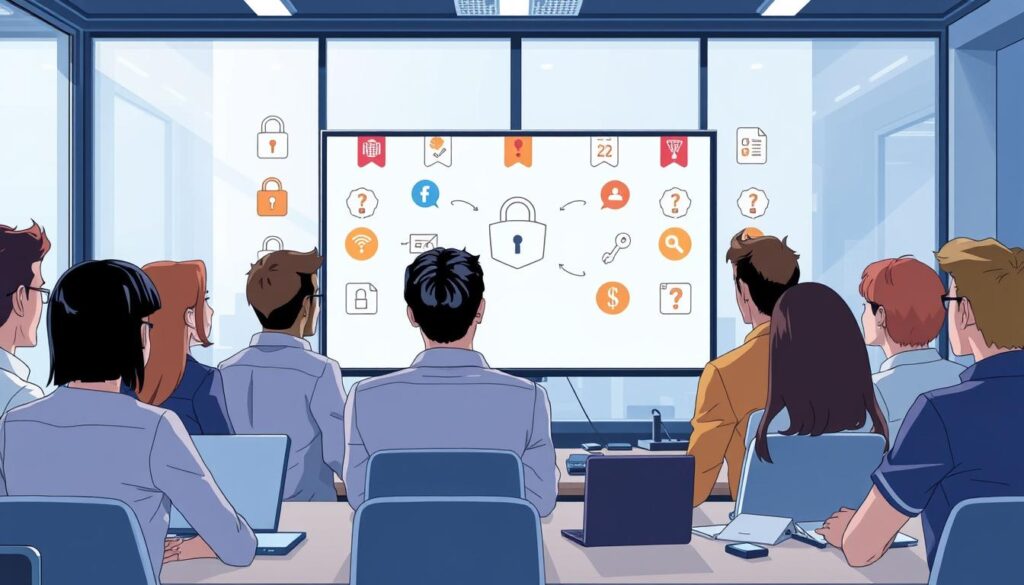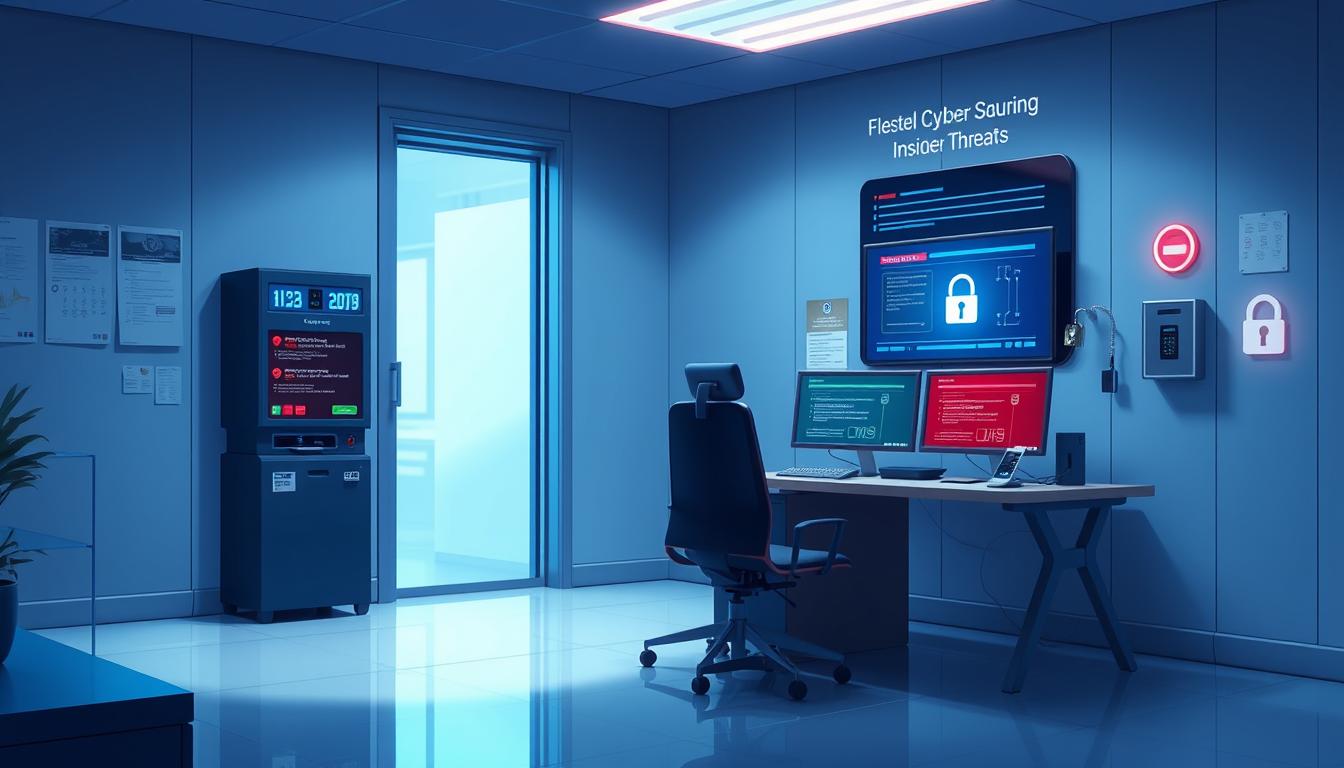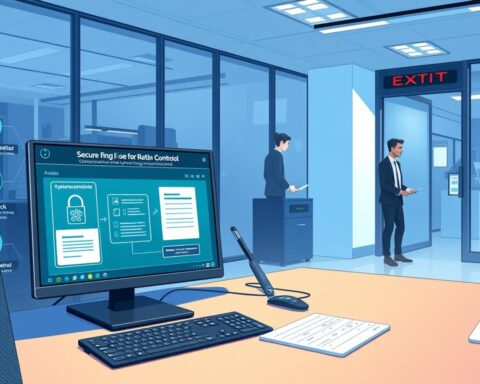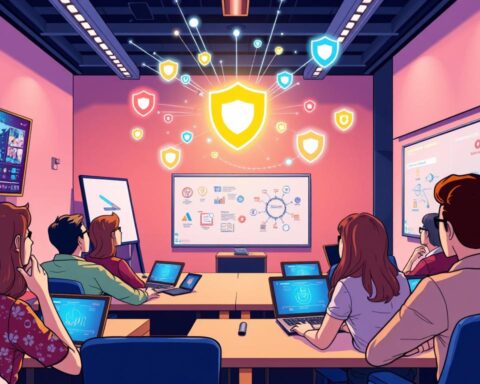Insider threats are a big problem, causing 60% of data breaches in companies1. This shows how critical it is to stop insider threats. You can do this with strong passwords, multi-factor authentication, and keeping software up to date. Also, watching what employees do online helps a lot.
Companies that teach their employees about security can cut insider threat risk by 70%1. This proves the value of good insider threat prevention and risk management plans.
Training employees often can lower insider threat risk by 50%1. Also, 77% of companies say that when employees know how their actions affect security, they make safer choices1. By using these methods, businesses can guard against insider threats and avoid expensive data breaches.
Key Takeaways
- Insider threats cause 60% of data breaches in organizations1
- Organizations with a formal security awareness training program can decrease the risk of insider threats by up to 70%1
- Regular employee training sessions can reduce the likelihood of insider threats by 50%1
- Implementing insider threat prevention and insider risk management strategies can protect organizations against insider threats
- Effective cybersecurity strategies can reduce the risk of costly data breaches
- Preventing insider threat incidents requires a combination of strong passwords, multi-factor authentication, regular software updates, and employee monitoring strategies
- Companies that prioritize security in executive decision-making can document a 25% increase in effective risk management outcomes2
Understanding the Insider Threat Landscape
Keeping sensitive data safe is a big deal for companies. Knowing about insider threats is key to good cyber security. These threats can be intentional, accidental, or when someone is tricked into doing harm. Data shows3 it takes 77 days to stop an insider threat. It costs about $7.12 million USD to handle it for over 30 days.
Watching over employees is vital to stop insider threats. Companies with lots of customer data or secrets are at high risk3. Threats from insiders often tie into bigger crimes like fraud or stealing data3. Here are some industries that face a lot of insider threats:
- Financial services organizations
- Insurance companies
- Telecommunications providers
- Energy and utility providers
- Manufacturing companies
- Pharmaceutical companies
- Healthcare institutions and hospitals
- Government agencies and high-ranking officials
Insiders cause about 34% of all data breaches4. Companies with a plan for insider threats can cut data loss by up to 50%4. Using strong cyber security and watching over employees can stop insider threats and keep data safe.
It’s critical for companies to get the insider threat picture. They need to create strong plans to stop and find insider threats. With good cyber security and watching over employees, companies can lower insider threat risks and keep their data safe5.
Key Components of Preventing Insider Threat Incidents
Stopping insider threats needs a mix of steps. This includes finding threats, stopping data breaches, and fixing internal issues. About 60% of data breaches come from insiders6. So, it’s key to have good ways to stop these threats.
Using threat detection can spot threats early. Stopping data breaches helps keep info safe. It’s also important to look at internal risks and fix them. This means doing security checks, training staff, and controlling who can access data.
By being proactive, companies can lower the chance of insider threats. The CERT National Insider Threat Center says it’s vital to check the risks from trusted insiders7. This shows how important it is to tackle internal threats.
Some ways to stop insider threats include:
* Using threat detection tools
* Doing regular security checks
* Teaching staff about security
* Setting up controls to stop data breaches
These steps help keep companies safe from insider threats. The 2023 Insider Threat Report says 74% of cybersecurity pros think their company is at risk8. This shows why stopping these threats is so important.
| Strategy | Description |
|---|---|
| Threat Detection Protocols | Implementing protocols to detect possible threats |
| Data Breach Prevention | Steps to stop data breaches |
| Internal Threat Mitigation | Looking at and fixing internal risks |
Building a Robust Security Framework
To stop insider threats, a strong security framework is key. It must have access controls, data classification, and clear policies. This framework guards sensitive data and blocks unauthorized access. Insider threats cause about 34% of data breaches, showing the need for solid programs9. Companies with insider threat programs are 50% better at spotting threats than those without9.
Security awareness training is vital in stopping insider threats. It teaches employees to protect data and understand insider threat risks. Companies that train employees well see a 90% drop in insider threats9. Also, employee monitoring strategies help catch and stop insider threats. This includes watching user actions and setting up access controls to keep data safe.
Key parts of a strong security framework are:
- Access controls to block unauthorized data access
- Data classification systems to protect sensitive data
- Clear policies and procedures to guide employee actions and prevent threats
By using these steps, companies can lower insider threat risks and safeguard their data. Regular checks and self-evaluations boost insider threat program success. Companies that audit or self-assess regularly see a 40% jump in compliance and effectiveness9.
In summary, a solid security framework is critical to prevent insider threats. It should have access controls, data classification, and clear policies. By training employees and using employee monitoring strategies, companies can protect their data. This makes a strong security framework essential10.
| Security Measure | Effectiveness |
|---|---|
| Access control measures | 50% reduction in insider incidents |
| Data classification systems | 40% improvement in data protection |
| Security policies and procedures | 90% reduction in possible insider incidents |
Employee Monitoring and Behavioral Analytics
Preventing insider threats is key in cybersecurity. Employee monitoring and behavioral analytics are essential for this. They help spot unusual behavior early, stopping big security problems11. This way, they catch both careless and unintentional mistakes11.
Behavioral analytics spot odd user actions, like too many login attempts. It also finds unusual data access patterns11. It can even show if an employee is stressed or unhappy, which might mean they’re at risk of being a threat11. By knowing what’s normal, any big changes can set off alarms, making security better11.
Monitoring and analytics also keep companies in line with rules by watching user actions11. This way, they can avoid big problems if something goes wrong11. It helps them move from just reacting to threats to actually stopping them before they start11. For more on how to spot insider threats, check out this resource for tips on managing insider risks and training employees.
Using employee monitoring and analytics can really cut down on insider threats. It helps catch both careless and intentional threats early12. This makes security better and helps keep data safe, all while keeping companies in line with rules13.
Implementing Technical Controls and Safeguards
Keeping sensitive data safe is key for any business. Using technical controls and safeguards is vital to stop insider threats. Studies show that 76% of companies face insider attacks, up from 66% in 201914. This shows the need for strong threat detection to catch and stop threats.
Businesses can use data loss prevention (DLP) solutions, network monitoring tools, and endpoint security. These tools help stop unauthorized access to sensitive data and spot insider threats. For instance, User and Entity Behavior Analytics (UEBA) technology sets a normal behavior baseline to spot odd behavior15.
Also, using least privilege policies and biometric authentication can lower insider threat risks15. Keeping an eye on unused accounts and privileges is also important to stop unauthorized access. By using these controls, businesses can keep their data safe and avoid insider threats.
Here are some key statistics on insider threats:
- 55% of insider threat incidents were due to human error16
- 25% of insider threat incidents involved criminal or malicious insiders16
- Organizations lose $16.2 million annually due to insider threats14
Understanding the need for technical controls and safeguards is important for businesses. They can protect their data and prevent insider threats by using threat detection protocols. This includes monitoring and analyzing behavior to spot insider threats15. By being proactive in cyber security, businesses can lower the risk of insider threats and keep their data safe.
| Control | Description |
|---|---|
| Data Loss Prevention (DLP) Solutions | Help detect and prevent unauthorized access to sensitive data |
| Network Monitoring Tools | Help identify and detect insider threats and odd behavior |
| Endpoint Security Measures | Help prevent unauthorized access and detect insider threats |
Creating an Effective Security Awareness Program
Security awareness training is key to any company’s cybersecurity plan. It teaches employees about risks and how to avoid them17. Monitoring employees can also help catch and stop insider threats. But, it’s important to do this in a way that respects privacy and civil rights18.
Creating a strong security awareness program involves several steps. These include regular training sessions, phishing simulations, and incident response planning. These help teach employees about risks and how to handle incidents. Also, using security awareness training programs can help stop insider threats.
By setting up a good security awareness program, companies can lower the chance of insider threats. This is done by  giving regular training to all staff. This can greatly reduce the risk of insider threats17.
giving regular training to all staff. This can greatly reduce the risk of insider threats17.
| Security Awareness Program Elements | Description |
|---|---|
| Regular Training Sessions | Education on how to avoid risks |
| Phishing Simulations | Testing employee awareness with fake phishing attacks |
| Incident Response Planning | Planning for how to handle insider threat incidents |
Response and Recovery Protocols
Having good response and recovery plans is key to stopping data breach prevention and internal threat mitigation. The IBM Cost of a Data Breach Report shows that having a team ready to handle incidents can save a lot of money. It can cut the cost of a breach by USD 473,706 on average19. This shows how important security awareness training is in stopping and handling insider threats.
Being able to spot and act on incidents fast is a big part of these plans. It takes 86 days on average to stop insider threat incidents20. This means organizations need to act quickly. They can do this by having incident response plans that cover containment, investigation, and recovery steps.
Some important steps in these plans are:
- Preparation: Identifying possible threats and planning how to deal with them
- Detection and analysis: Fast identification and analysis of incidents to understand their size and effect
- Containment: Quick action to stop incidents and prevent more damage
By taking these steps and having good response and recovery plans, organizations can lessen the damage from insider threats. They can also keep their sensitive data safe21.
Regular security awareness training and constant monitoring help stop insider threats and make response times better. By focusing on internal threat mitigation and data breach prevention, companies can lower the risk of insider threats. This helps protect their valuable assets192021.
Conclusion: Strengthening Your Organization’s Defense Against Insider Threats
Stopping insider threats is key for keeping systems and data safe. These threats, whether on purpose or by accident, can really hurt because they come from inside22. The damage can be huge, with some cases costing over $6 million22.
To fight these threats, using strong security plans is a must. This means watching employee actions, using special software, and teaching employees about security. By focusing on stopping insider threats, companies can save money and keep their good name22.
Using User Behavior Analytics (UBA) can spot odd behavior and find insider threats with high accuracy22. Also, Data Loss Prevention (DLP) systems can cut down on data breaches by 30% if used right22. Taking steps early on can help protect against insider threats and keep data safe.
It’s vital for companies to understand the danger of insider threats and act to stop them. This way, they can avoid big losses, keep their reputation strong, and keep their data and systems safe22.
FAQ
What are insider threat incidents and why are they a concern for organizations?
What are the types of insider threats and how can they be prevented?
What is the cost impact of insider threat incidents and how can organizations mitigate these costs?
What are the key components of preventing insider threat incidents and how can they be implemented?
How can organizations build a robust security framework to prevent insider threat incidents?
What is the importance of employee monitoring and behavioral analytics in preventing insider threat incidents?
How can organizations implement technical controls and safeguards to prevent insider threat incidents?
What is the importance of creating an effective security awareness program in preventing insider threat incidents?
How can organizations implement response and recovery protocols to prevent insider threat incidents?
Source Links
- 31 Practical Tips for Cyber Security Awareness Month | Digital Jersey – https://www.digital.je/news-events/digital-news/31-practical-tips-for-cyber-security-awareness-month/
- Issue #11: The Evolving Role of IT and Security Teams: A Company – Wide Responsibility – https://www.linkedin.com/pulse/issue-11-evolving-role-security-teams-company-wide-umang-mehta-lgpbf
- Insider Threats And How To Identify Them – https://www.crowdstrike.com/en-us/cybersecurity-101/identity-protection/insider-threat/
- Insider Threat | Software Engineering Institute – https://www.sei.cmu.edu/our-work/insider-threat/
- What Is an Insider Threat? Definition, Types, and Prevention | Fortinet – https://www.fortinet.com/resources/cyberglossary/insider-threats
- 17 Ways To Prevent Insider Threats: Steps, Tips & Tools – https://www.teramind.co/blog/how-to-prevent-insider-threats/
- The 13 Key Elements of an Insider Threat Program – https://insights.sei.cmu.edu/blog/the-13-key-elements-of-an-insider-threat-program/
- 5 best practices to protect and prevent insider threats – https://www.nextdlp.com/resources/blog/best-practices-prevent-insider-threats
- Creating an Insider Threat Program | Cyberhaven – https://www.cyberhaven.com/guides/creating-an-insider-threat-program
- Insider Threat Prevention Best Practices – https://www.netwrix.com/insider-threat-prevention-best-practices.html
- Leveraging Behavioral Analytics for Insider Threat Detection – https://www.linkedin.com/pulse/leveraging-behavioral-analytics-insider-threat-detection-co6ke
- How to Detect Insider Threats (And Stop Them From Happening) – https://www.teramind.co/blog/insider-threat-detection-techniques/
- Mitigating Insider Threats: The Power of AI in Corporate Surveillance – https://pavion.com/resource/mitigating-insider-threats-the-power-of-ai-in-corporate-surveillance/
- How to Prevent Insider Threats: Implementing Least Privilege Access Best Practices – Apono – https://www.apono.io/blog/how-to-prevent-insider-threats/
- 16 Ways To Prevent Insider Threats and Detect When They Occur – https://pathlock.com/learn/16-ways-to-prevent-insider-threats-and-detect-when-they-occur/
- The Top Insider Threat Indicators & How to Safeguard Your Organization – https://www.lmgsecurity.com/the-top-insider-threat-indicators-how-to-safeguard-your-organization/?srsltid=AfmBOooLkk-SUiMHbVR-NvhYTRcTCuY4DKjrRs9xXzV_RFHmtE85zJvX
- PDF – https://www.sifma.org/wp-content/uploads/2018/02/insider-threat-best-practices-guide.pdf
- INT122 Student Guide – https://www.cdse.edu/Portals/124/Documents/student-guides/INT122-guide.pdf?ver=gv49CX6Smq9Zyj9Bhxd4gw==
- What is Incident Response? | IBM – https://www.ibm.com/think/topics/incident-response
- 6 Strategies For Mitigating Insider Threats | Resolver – https://www.resolver.com/blog/mitigating-insider-threats-strategies/
- Insider Threats: Safeguard Against Internal Risks – https://www.oneleet.com/blog/insider-threats
- Mitigating Insider Threats: Strengthening Your Organization’s Core Defenses – https://www.linkedin.com/pulse/mitigating-insider-threats-strengthening-your-core-defenses-chandel-2nqvc










